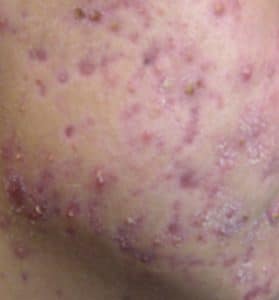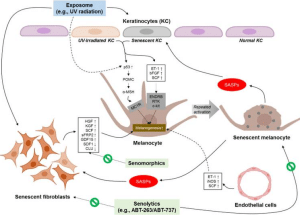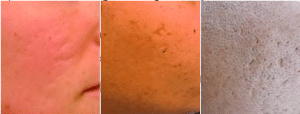They usually occur in fair skin children as well as adults. They are light brown macules Usually seen on face, on the shoulders and commonly on chest. The important diagnostic feature is they vary with season and exposure to sunlight. They are darker in the summer and fade in winter, you see normal number of skin melanocytes but there is an increase in melanin pigment not only in skin melanocytes but in epidermal cells as well and pigmentation usually occurs in basal cell layer of epidermis.
Freckles respond well to 2-3% kojic acid or hydroquinnone preparations as well as a combination of glycolic acid and retinoic. Kojic acid is a natural ingredient, more friendly to the skin whereas hydroquinone with proven side effects, found evidently harsh to the skin. Night Treatment, which leverages various botanical extracts, confers promising results in elimination of freckles and even-toning the skin.
| They are flat, red or reddish spots that are the final stage of most inflamed acne lesions. After an inflamed acne lesion flattens, a macule may remain to “mark the spot” for up to 6 months. When the macule eventually disappears, no trace of it will remain—unlike skin scarring. |
 Acne lesions associated with various scarring, acne spots are seen in number in this patient |
| Aging related hyperpigmentation have been found to be multifactorial and various mechanisms have been described in their pathology. Age spots are not an increase in number of melanocytes, what is seen in a nevus, but rather a clumped melanin in a melanocyte on one side as well as dysfunctional, senescent endothelial cells on the other. Age spots may be result of UV exposure once the melanocytes are less functional to get rid of excess melanin as a result of aging. Here you can find more information about age spots. |
 Aging related changes in the skin which lead to hyperpigmentation spots tend to be multifactorial |
Kojic acid preparations as well as hydroquinnone are equally effective in eliminating acne spots, freckles, sun burned pigmented skin and various dark patches of hyper pigmentation by even- toning the skin and reducing production of melanin in skin melanocytes. However, kojic acid tend to be safer and more skin friendly to treat skin’s discolorations. Hydroquinone is an skin irritant. Hippocrates Scars Treatment Kit contains kojic acid and is our formulation for skin hyper pigmentation. Please see products page for more information.
Albinism: It is a failure of pigment production by otherwise intact melanocytes. It occurs in two variants of hypo pigmentation.
1. Ocular albinism is a melanin by dysfunction that is limited to the yes. This condition is an X-linked disorder.
2. Oculocutaneous albinism is a melanin synthesis defect that involves the eyes, skin, and hair, it predisposes to actinic keratosis, basal and squamous cell carcinoma, and malignant melanoma because of sensitivity of the skin to sunlight. Inheritance is almost often autosomal recessive. Oculocutaneous albinism is often subclassified as:
a. Tyrosianse-negative albinism, which is failure of conversion of tyrosine to dihyrdropheylalanine (DOPA), an intermediary in melanin synthesis.
b. Tyrosinase-positive albinism. The mechanisms of deficient melanin synthesis are unknown.
This type of pigmentation is discoloration of the skin at the site of a healed or healing inflamed acne lesion. These hyperpigmentation acne scars occur more frequently in dark skin individuals, but occasionally is seen in people with white skin. Early acne treatment by a dermatologist may minimize the development of pigmentation with scarring.
Some of hyperpigmentation acne scars may persist for up to 18 months, especially with excessive sun exposure. Chemical peeling may hasten the disappearance of acne scars with pigmentation.
Kojic acid appears as effective as hydroquinone for treatment of hyper pigmentation associated with acne scar. Kojic acid is much safer compare to its rival and less irritating to the skin. It is natural element derived from a Japanese mushroom. Complete removal of hyperpigmentation acne scars is very likely and the outcomes sound very satisfactory. Here you can find more information on post inflammatory pigmentation.
| Acne scars with some level of atrophy may be seen in various forms, icepick scars, rolling scars, boxcar scars which are different from what is seen in acne spots, associated with alterations in skin pigmentation. Nevertheless, atrphic changes may often be seen with hyperpigmentation as residues of prolonged course of acne vulgaris. |
 Acne scars with atrophic changes, from left to right: rolling scars, boxcar scars and icepick scars |
Vitiligo is among skin disorders of pigmentation with an auto immune etiology. There is antibody against skin melanocytes in the serum of affected individuals. Patches of depigmentations is seen. Fairly common, may affect any race. It can happen in African American, as well as Caucasians. The key pathology in this disease is depigmented areas are devoid of melanocytes, involving trunk and extremities. There are some treatment options for this disorder including ultraviolet therapy.
Among other pigmentation disorders is melasma. Melasma is a common acquired hyper pigmentation characterized by irregular light-brown to gray-brown macules involving the face, especially the cheeks, forehead, upper lips, nose, and chin, more frequently seen around the eyes. It’s also called mask of pregnancy. Blotchy patches of hyper pigmentations is seen. Could happen with oral contraceptive use and pregnancy. The good news is, it may regress after the pregnancy is over.
Current treatments for melasma include broad-spectrum sunscreens, 2- 4% hydroquinone creams or other bleaching creams such as kojic acid creams. Among others azelaic acid, alpha and beta hydroxy acid products, retinoic acid, retinol, superficial chemical peels, and microdermabrasion could be named.
A combination cream such as hydroquinone and retinoic acid cream could provide more satisfactory results. Laser acne scar treatment offers minimal long-term success and the likelihood of worsening the condition exist. None of the treatments named above cure melasma and continual use of creams is essential to maintain the results. Sun protection is essential part of any regimen for treating melasma.
Another agent which has been highlighted by a recent study is silymarin. This study indicates that silymarin 1.4% may be as efficient as hydroquinone 2% in treatment of mixed-type melasma. Silymarin has been found far safer than hydroquinone in improving skin hyperpigmentation spots.
| While Hippocrates Labs would be introducing specific melasma treatment in 2023, we offer Night Treatment as an effective treatment for this skin condition. Night Treatment, is an anti aging serum with proven results in eliminations of age spots, freckles and hyperpigmentations related to melasma. |
 An anti aging night serum to treat age spots, freckles and skin hyperpigmentations |
This a benign localized proliferation of melanocytes. Tends to produces small oval light brown macules. Linear proliferation of melanocytes.Congenital nevi. Present at birth. Giant nevi has increase risk of developing melanoma.If it changed color or became raised you have to be worried. If you see hair coming off it wouldn’t be melanoma.
In melanoma you never see hair coming off.Nevoclelluar nevus, Mole. It is benign tumor of melanocytes. Clearly related to sun exposure. It is acquired, sharply well demarcated border tends to have nice oval symmetrical shape, very uniform pigmentation and tend to remain stable, they do not change in shape and size. They are benign and malignant transformation is very uncommon.
Melanoma, its incidence is increasing. Melanoma peaks in ages 40-70. Risk factors are fair skin, chronic sun exposure especially during child hood. It is most often associated with excessive exposure to sunlight. Dysplastic nevus syndrome. Grossly, they are asymmetric, irregular in shape. tends to be varied in color, red, orange, brown. Large in diameter and tend to have a history, becoming larger and elevated over time. They could be seen in any sun exposed area of the body.
Nodular form has the worst prognosis because it invades the underlying vasculature. The most important prognostic factor is the depth of lesion. The treatment is wide surgical excision. In some case is spontaneously regressed.
The most important clinical variants include:(1) Lentigo malingna melanoma. Occurs on sun-exposed skin. The radial growth phase predominates initially, most often develops from preexisting lentigo maligna (Hutchinson freckle).(2) Superficial spreading melanoma is the most common of the variants. The lesion is irregularly bordered with variegated pigmentation, most frequent locations are the trunk and extremities. Radial growth phase predominates.
(3) Nodular melanoma begins with the vertical growth phase. It has the poorest prognosis of the clinical variants.(4) Acral-lentiginous melanoma most often appears on the hand and feet of dark skin individuals.
| Serum for hyperpigmentation acne scars and spots. Our regimen, based on personalized skincare, results in an effective elimination of skin hyperpigmentation and discolorations, pigmentation spots and hyperpigmentation acne scars using gradual acne scars skin resurfacing and dermal repair.This method even tones the skin using high potency serums. We have developed an skin care tailored for hyperpigmentation acne scars using high-potency serums. |
 Acne scars treatment serum |
This skin care system changes your skin dramatically within one month. What will be more noticeable is the glow and radiance in your complexion rather than skin discolorations.This regimen for removal of hyperpigmentation acne scars even tone your skin in less than two weeks and provides a radiant appearance to the skin. Resurfacing serum works on the surface of the skin, epidermis, as well as deep within the dermis layer. It benefits from retexturizing properties of different renewal agents such as retinol, AHAs and BHA’s for skin reconstruction.
Serum for acne scars treatment also provides the skin with the nutrients it needs the most to make up for lost nutrients while the epidermis involves with rigorous skin renewal. The result is a new skin, where hyperpigmentation acne scars is hardly recognizable because overall smoothness of the skin overwhelms the gradually-disappearing scars. Our motto is, “we don not promise miracles, yet we do promise results”.
This resurfacing treatment changes the overall appearance of your skin from tone and texture to resiliency and smoothness. The skin becomes noticeably smoother and younger, while the appearance of acne scars diminishes. General smoothness of your skin undermines the gradually disappearing scars.
Stimulation of connective tissue fibers’ synthesis in dermis layer is another target of these serums to correct hyperpigmented skin.This kit helps to increase epidermal subepidermal microcirculation, restores dermal metabolic functions and stimulates collagen remodeling, which is disrupted during hyperpigmentation acne scars formation. Please navigate through our site to become more familiar with the choices you have to treat skin scars.